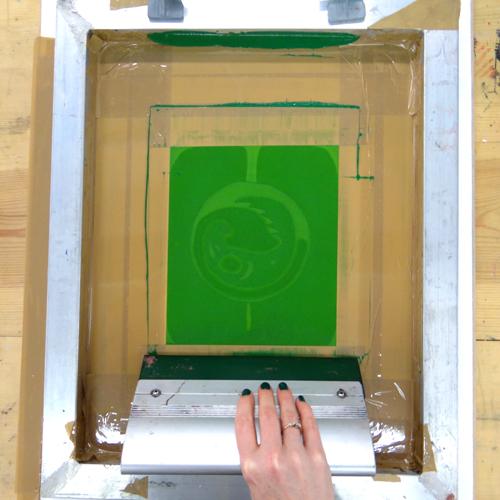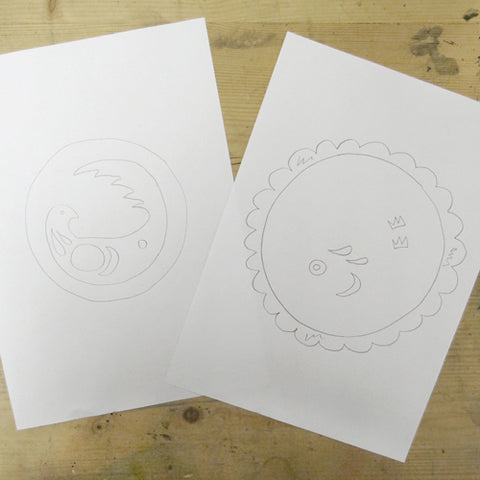How to Screen Print with Paper Stencils

In this project we will show you how to screen print onto paper using paper stencils. With this method, you can print multiples of your designs in several layers of flat colour without having to make an exposed screen or using screen filler. When screen printing, ink is forced through a fine mesh onto a flat surface. A paper stencil will block areas of the paper from receiving ink, creating your design. When using a paper stencil, you should be able to get 10 – 25 prints made before the stencil starts to deteriorate.

Standard copy paper works best for paper stencils. It is thin enough to achieve sharp edges but strong enough to block the wet ink. Acetate stencils, although washable, can slip and ink can get underneath them. Trace your drawing into your separate parts. Each stencil will be printed in a different colour. This design is being printed in two colours. When making a screen printing stencil, not all the parts have to be connected – you can have ‘islands’ that you put down in the correct place before printing.

Use a scalpel and a cutting board to cut out your stencils.

If your stencils are comprised of different cut out elements, like these ones, use allows and pencil marks to help you line up the different pieces so that they don’t get twisted and misaligned when laying them down.

Next, prepare your screen. A 90T mesh screen is best for printing onto paper. We are using an A3 sized screen with an A4 stencil in the centre. Use parcel tape on the front and back of the screen to block the mesh around the edges. You want to leave an opening that is smaller than your stencil but allows your whole design to fit inside. Tape the back of the screen in the same way, sandwiching the mesh between the two layers
of tape.

Hinge clamps are an easy way to print a registered (lined-up) image and to print multiples of one print. These hinge clamps are attached to a board. The screen is held in the clamps and can be lifted up and down on the hinges. Each time it is placed down on the board it is in the same position.
Place your paper down on the board and your stencil on top. If using hinge clamps, put your screen down on top to make sure your whole design fits within the opening.

It can help to spray a little low-tack spray mount down on your surface to hold your printing paper in place and stop it from sticking to the screen. Mark the location of the corners of your paper with masking tape. That way you can place each piece of paper in the correct place.

Acrylic screen printing inks are used for printing onto paper. You can make your own acrylic inks by mixing acrylic paint with System 3 Acrylic Screen Printing Medium in a 50:50 ratio. If the proportion of acrylic paint is too high, the paint will dry in the screen and cause permanent blockages. You can make the colours more translucent by adding more medium to the mix.


If using hinge clamps, lift the edge of your screen and prop it onto something like a roll of tape. This holds the screen away from the paper whilst you flood it. Scoop a line of ink along the bottom edge of the opening of your screen.

Use a squeegee that is slightly wider than your design. Hold your squeegee at a 45 degree angle away from you to drag the ink up the screen. You don’t need to press hard
at this point. This is called a flood. If you prefer, you can place your ink at the top on the screen and flood down the mesh instead of up.

The holes in your mesh should be filled with a thin layer of ink. If there are any patched left open, flood again.

Remove your chocks and place the screen flat on the board. Holding the squeegee at a 45 degree angle towards you, pull the squeegee down the screen. You need to press firmly and should hear a sound resembling a tent zip. You do not need to add any more ink for this squeegee pull, we are just pushing the ink from the flood through the mesh and onto the paper.

Carefully lift your screen to reveal your print. The ink should have stuck the paper stencil to the screen.


Place the next piece of printing paper on the board using your masking tape corners as a guide. Once you have started printing, your ink is at risk of drying in the screen so you will need to work fairly quickly between prints. Once you have finished this layer, peel off the stencil and use a wet, soft sponge to clean the remaining ink off the screen.
When your first print layer is dry, place a print onto your board. Put your second stencil over the top of your print, lining up the different elements. Check your screen is dry and that your whole design will fit in the opening when it’s placed down.

For this second layer we are using a pre-mixed Acrylic Screen Printing Ink by Speedball in Gold. Pre-mixed inks do not need any medium added. Lift your screen slightly and flood with the second colour.
Place your screen down and pull the squeegee down the screen, pressing firmly.
Life to reveal your two layer print! Print the rest of your edition using the same method and then peel off your stencil and wash the screen thoroughly.

To make a paper stencil screen print you will need:
- 90T Screen
- Copy Paper
- Pencil
- Scalpel
- Parcel Tape
- Board with Hinge Clamps (optional but helpful)
- Spray Mount (optional)
- Paper for Printing
- Masking Tape
- Acrylic Paint and Acrylic Screen Printing Medium OR
- Speedball Acrylic Screen Printing Ink
- Squeegee
- Soft Sponge
